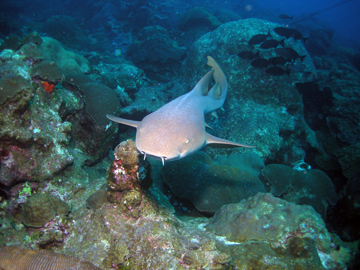
by Rick O'Connor | Nov 13, 2020
This is not a word that most visitors to the beach want to hear. However, shark attacks are actually not that common and the risk is very low. People hear this every year on shark programs, but it does not seem to make them feel any better. Here is what the International Shark Attack File says (as of 2020)…
– Since the year 1580 there have been 3164 unprovoked shark attacks around the world.
Let that sink in for a moment… 3000 unprovoked attacks on humans in the last 440 years.
Now consider the number of car accident victims that have occurred in the last month within the United States. See what they are getting at? Let’s look at more…
– Of the 3164 reported unprovoked attacks (yes… these data only include what was reported) 1483 were from the United States… 47% of them. This may be due to the fact we are “water people”. The other top countries are Australia, South Africa, and Brazil, all “water people” as well.
– Of the 3164 reports 851 were from Florida (27%). This is the number of reported shark attacks in our state since the Spanish settled it. This comes out to 2 each year – though the data shows a sharp increase in attacks starting in the 1970s (most have occurred since then).
– Of the 3164 reports 25 were from the panhandle region (0.8%) and 7 from the Pensacola Bay area (0.2%).
Let that sink in for a moment. Seven reported attacks from the Pensacola Beach area since the time DeLuna landed here in 1559… 7.
And lets once again consider the number of vehicle accidents that will occur in the bay area today.
These numbers have been posted before. Yet people are still very worried when the hear sharks are in the Pensacola Beach region. When attacks occur, they are big news. The International Shark Attack File does give trends and suggestions on what to do. But as many say, sharks are the least of your worries when you are planning a day at the beach.
Now that we have said all of that, they are truly amazing animals.
They are fish but differ in that their skeletons lack hard calcified bone – they are cartilaginous. There are 25 species in 9 different families in the Gulf of Mexico. Many are completely harmless – 13 of the 25 have been reported to have had unprovoked attacks somewhere around the world – the white, tiger, and bull sharks leading the way. Several rarely come close to shore.
Sharks lack a swim bladder and thus cannot “float” in the water column the way your aquarium fish do. Some, like the nurse and angel sharks, rest on the bottom. Others, like the white and blue sharks, swim constantly to get water flowing over their gills.
Because of this, they are very streamlined with reduce scales. They actually have modified teeth for scales – called placoid scales. Their fins are angular and rigid (as are other open water fish) and some can swim quite fast – makos have been clocked at over 30 mph for short distances. Many have seen video of large white sharks exploding with a burst of speed on a sea lion and actually leaping out of the water with it.
Many species do lay eggs, but others keep the eggs within and give live birth after they hatch. One species, the sand tiger, produce four embryos within the mother. The first to hatch consumes the other three!
The teeth of sharks are famous. Rows of them, some pointed, some are serrated, all are designed to cut and swallow. The tiger shark has a serrated tooth that is angled like a can opener. They can use this to “open” sea turtle shells – adding them to their rather large menu. They “shed” these frequently – placing a new sharp tooth where the dull old one was – and will go through tens of thousands of teeth in a lifetime.
The sensory system is one of the most amazing in the world. Tiny gelatinous cells along their sides, called the lateral line, detect pressure waves from great distances. Splashing, thrashing movements made by fish can be detected a mile away – and get their attention. As they approach the sound their sense of smell kicks in. It has been said that a shark can detect one drop of blood in thousands of gallons of water – and it is true. However, the sharks must be down current of the victim to detect it. Their eyes are much better than most think. They have “crystals” within their retina that act as mirrors reflecting light that enters. Imagine turning on a flashlight in a dark room. Now imagine doing this if the walls and ceiling were mirrors – you kind of understand how they can actually see pretty well even in the low light. That said, light does not travel well under water, so they rely on their other senses more. And as if that were not enough. They have small gelatinous cells around the head region that can detect small electric fields. When a shark bites, it must close its eyes and – as the fishermen say – “roll back” out of the head. At this point the shark is basically blind and cannot see the target it is trying to bite. However, if you move out of the way, the weak electric fields produced by your muscles in doing so can be detected by these cells and the shark knows where you are.
Cool – and scary at the same time. Let’s meet a few of these amazing fish in our area.
https://www.floridamuseum.ufl.edu/shark-attacks/
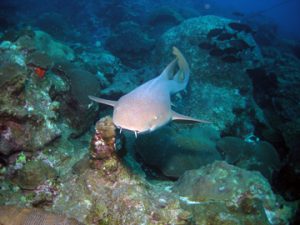
The nurse shark. Notice the barbels (whiskers) on its head.
Photo: NOAA
Nurse Shark
This is one of the bottom dwelling sharks that appear harmless – and they are – but if provoked, they will bite. They have less angular fins, or a brownish-bronze color, and really like structure – they are found on our reefs. They posses a “whisker-like” structure called a barbel. These are common on other bottom fish, like catfish, and possess chemo-sensory cells to detect prey buried in the sand. They are not as common here as they are in the Keys, but they have been seen. They can reach lengths of 14 feet.
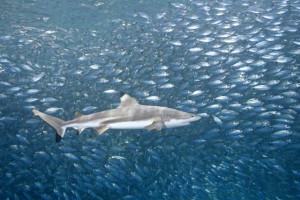
Blacktip sharks are one of the smaller sharks in our area reaching a length of 59 inches. They are known to leap from the water. Photo: Florida Sea Grant
Blacktip – Spinner
These are grouped together because (a) they resemble each other, and (b) they are both common here.
They are both stream-lined in shape and have blacktips on their fins. Actually, spinner sharks have more fins tipped-black than the blacktip. The anal fin of the spinner is tipped black, but this is not the case for the blacktip. The spinner gets its name from the habit of leaping from the water and spinning very fast as it does so. Both are quite common in the Gulf and the bay. They reach about eight feet in length and unprovoked attacks are very rare.
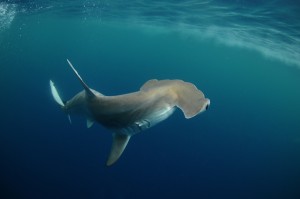
The Scalloped Hammerhead is one of five species of hammerheads in the Gulf. It is commonly found in the bays. Photo: Florida Sea Grant
Hammerheads
This is a creepy group – check out the head. It is one that many people fear, and unprovoked attacks have occurred. The reader may not know that there are more than one kind – five species actually. They have a tall dorsal fin which sometimes extends above the water when swimming near the surface – the classic “shark is coming” look. Their heads are aerofoil shaped and there are several possible explanations for this. 1) It is more aerodynamic, making it easier for this ram-jetter to swim, using less energy to do so. 2) It is a battery of sensory cells. By swinging the head back and forth, as they do, it is an advanced radar searching for prey, possibly finding it before other sharks do. There are stories of hammerheads arriving first. 3) It is also believed they use their electric sense to detect buried prey – the shape making this easier to find and expose them. It could very well be that all of these could explain the shape.
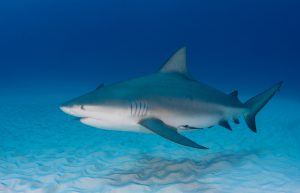
This pregnant bull shark has an impressive girth.
Bull Shark
Since the film Jaws the world has turned its attention from solely the white shark – to the bull shark. As you can imagine, it is hard for a shark attack victim to tell you which species bit them – “I don’t know… it was a big gray thing chomping on my leg!” or “It was a great white!” because that is the only one many know. But studies sine the 1970s suggest that the bull shark is an aggressive species and may be responsible for a lot of attacks. Particularly in the estuaries and upper estuaries. Bull sharks are what we call euryhaline – they have tolerance for a wide range of salinities. This shark has been reported in low salinities of the upper estuaries and even into freshwater rivers. One report had them over 100 miles from the coast – they are certainly where the people are.
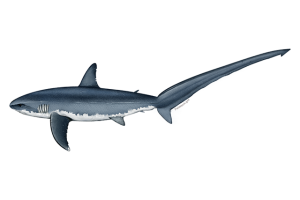
The extremely long upper lobe of the thresher shark.
Image: NOAA
Thresher Sharks
These are bizarre looking sharks. Most sharks have what we call a heterocercal tail – different – different meaning the upper lobe of the forked tail is longer than the lower. But the threshers take this to the extreme – the tail can make up almost half of their body length, which can be 20 feet. It is believed that use this extremely long tail to herd and stun baitfish – their favorite prey. They prefer colder waters and records in the Gulf are not common. Those that exist suggest they live offshore and are rarely encountered near beaches. There are no unprovoked attacks reported from this shark.
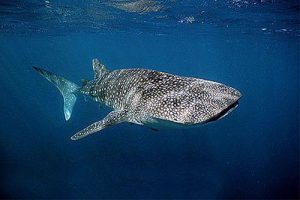
The massive whale shark.
Photo: Florida Museum of Natural History.
Whale Shark
Amazing… heart stopping… what else can you say. Encounters with the largest fish on our planet are rare – but when they do happen you will never forget it – it will be one of the highlights of your life. As the name suggest – these are large sharks, with a mean length of 45 feet but some reporting in at 60 feet. They are easily recognized first by their size, but also their coloration. They are brownish color with beige or white spots in nice rows running across the dorsal side. They swim slowly filtering plankton from the sea – though will occasionally take in a fish. Some reports show them vertical in the water column moving up and down filtering from a school of plankton or tiny fish. They are rarely seen because they tend to dive deeper during the day with the plankton layer – then surfacing at night following the same plankton. They are, unfortunately, sometimes struck by boats while at the surface.
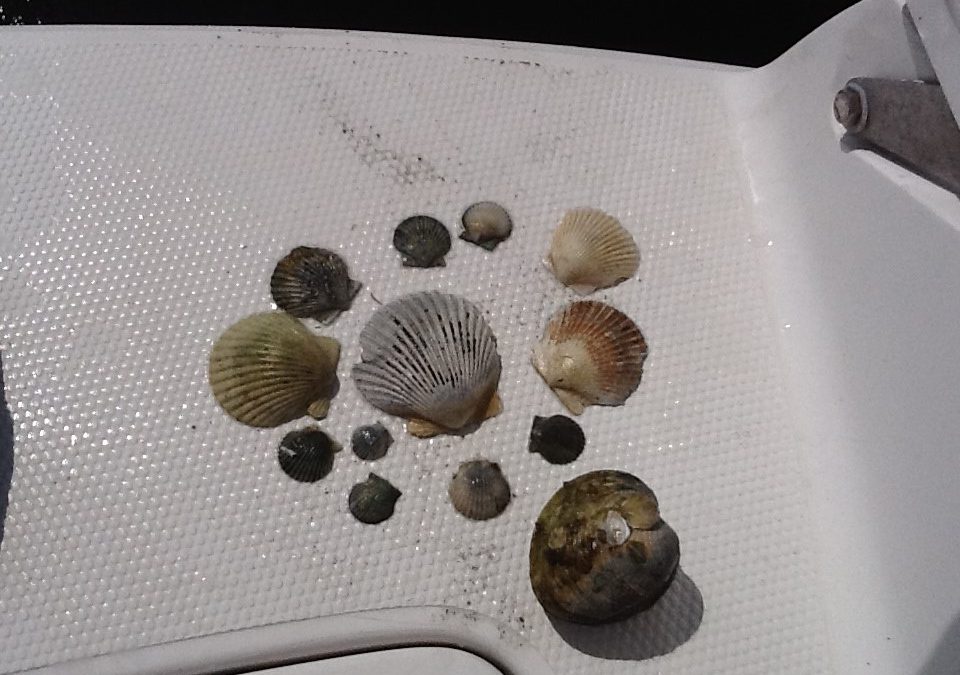
by Rick O'Connor | Jun 26, 2020
This is a good name for this group. They are mollusk that have two shells. They tried “univalve” with the snails and slugs, but that never caught on – gastropods it is for them. The bivalves are an interesting, and successful, group. They have taken the shell for protection idea to the limit – they are COMPLETELY covered with shell. No predators… no way. But they do have predators – we will talk more on that.
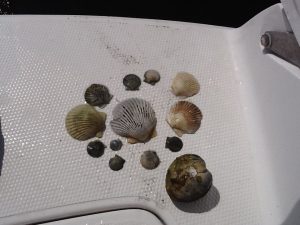
An assortment of bivalves, mostly bay scallop.
Photo: Florida Department of Environmental Protection.
As you might expect, with the increase in shell there is a decrease in locomotion – as a matter of fact, many species do not move at all (they are sessile). But in a sense, they do not care. They are completely covered and protected. Again, we will talk more about how well that works.
The two shells (valves) are connected on the dorsal side of the animal and hinged together by a ligament. Their bodies are laterally compressed to fit into a shell that is aerodynamic for burrowing through soft muds and sands. Their “heads” are greatly reduced (even missing in some) but they do have a sensory system. Along the edge of the mantle chemoreceptive cells (smell and taste) can be found and many have small ocelli, which can detect light. The scallops take it a step further by having actually eyes – but they do live on the surface and they do move around – so they are needed.
The shells are hinged together at the umbo with “teeth like structures and the shells open and close using a pair of adductor muscles. Many shells found on the beach will have “scars” which are the point of contact for these muscles. They range is size from the small seed clams (2mm – 0.08”) to the giant clam of the Indo-Pacific (1m – 3.4 ft) and 2500 lbs.! Most Gulf bivalves are more modest in size.
Being slow burrowing benthic animals, sand and mud can become a problem when feeding and breathing. In response, many bivalves have developed modified gills to help remove this debris, and many actually remove organic particles using it as a source of food. Many others will fuse their mantle to the shell not allowing sediment to enter. But some still does and, if not removed, will be covered by a layer of nacreous material forming pearls. All bivalves can produce pearls. Only those with large amounts of nacreous material produce commercially valuable ones.
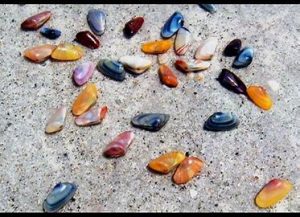
Coquina are a common burrowing clam found along our beaches.
Photo: Flickr
Another feature is the large foot, used for digging a burrowing in the more primitive forms. It is the foot we eat when we eat clams. They can turn their bodies towards the substrate, begin digging with their foot but also using their excurrent from breathing to form a sort of jet to help move and loosen the sand as they go – very similar to the way we set pilings for piers and bridges today.
These are the earliest forms of bivalves – the burrowers. Most are known as clams and most live where the sediment is soft. Located near their foot is a sense organ called a statocyst that lets them know their orientation in the environment. Most have their mantles fused to their shells so sand cannot enter the empty spaces in the body. To channel water to the gills, they have developed tubes called siphons which act as snorkels. Most burrow only a few inches, some burrow very deep and they are even more streamlined and elongated.
Some have evolved to burrow into harder material such as coral or wood. One of the more common ones is an animal called a shipworm. Called this by mariners because of the tunnels they dig throughout the hulls of wooden ships, they are not worms but a type of clam that have learned to burrow through the wood consuming the sawdust of their actions. They have very reduced shells and a very long foot.
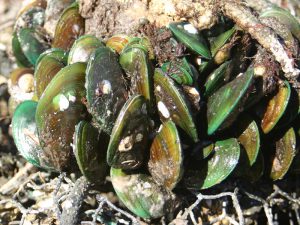
This cluster of green mussels occupies space that could be occupied by bivavles like osyters.
Other bivalves secrete a fibrous thread from their foot that is used to grab, hold, and sometimes pull the animal along. These are called byssal threads. Many will secrete hundreds of these, allow them to “tan” or dry, reduce their foot, and now are attached by these threads. The most famous of this group are the mussels. Mussels are a popular seafood product and are grown commercial having them attach to ropes hanging in the water.
Another method of attachment is to literally cement your self to the bottom. Those bivalves who do this will usually lay on their side when they first settle out from their larval stage and attach using a fluid produced by the animal. This fluid eventually cements them to the bottom and the shell attached is usually longer than the other side, which is facing the environment. The most famous of these are the oysters. Oysters basically have lost both their “head” and the foot found in other bivalves. These sessile bivalves are very dependent on tides and currents to help clear waste and mud from their bodies.
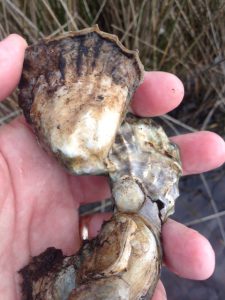
Oysters are a VERY popular seafood product along the Gulf coast.
Photo: Rick O’Connor
Then there are the bivalves who actually live on the bottom – not attached – and are able to move, or even swim. Most of these have well developed tentacles and ocelli to detect danger in the environment and some, like the scallops, can actually “clap their shells together” to create a jet current and swim. This is usually done when they detect danger, such as a starfish, and they have been known to swim up to three feet. Some will use this jet as a means of digging a depression in the sand they can settle in. In this group, the adductor has been reduced from two (the number usually found in bivalves) to one, and the foot is completely gone.
As you might guess, reproduction is external in this group. Most have male and female members but some species (such as scallops and shipworms) are hermaphroditic. The gametes are released externally at the same time in an event called a mass spawning. To trigger when this should happen, the bivalves pay attention to water temperature, tides, and pheromones released by the opposite sex or by the release of the gametes themselves.
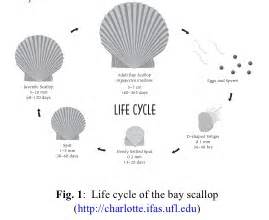
Scallop life cycle.
Image: University of Florida IFAS
The fertilized eggs quickly develop into a planktonic larva known as a veliger. This veliger is ciliated and can swim with the current to find a suitable settling spot. Some species have long lived veliger stages. Oysters are such and the dispersal of their veliger can travel as far as 800 miles! Once the larval stage ends, they settle as “spat” (baby shelled bivalves) on the substrate and begin their lives. Some species (such as scallop) only live for a year or two. Others can live up to 10 years.
As a group, bivalves are filter feeders, filtering organic particles and phytoplankton as small as 1 micron (1/1,000,000-m… VERY small). In doing this they do an excellent job of increasing water clarity which benefits many other creatures in the community. As a matter of fact, many could not survive without this “eco-service” and the loss of bivalves has triggered the loss of both habitat and species in the Gulf region. Restoration efforts (particularly with oysters) is as much for the enhancement of the environment and diversity as it is for the commercial value of the oyster.
Now… predators… yes, they have many. Though they have completely covered their bodies with shell, there are many animals that have learned to “get in there”. Starfish and octopus are famous for their abilities to open tightly closed shells. Rays, some fish, and some turtles and birds have modified teeth (or bills) to crush the shell or cut the adductor muscle. Sea otters have learned the trick to crush them with rocks and some local shorebirds will drop them on roads and cars trying to access them. And then there are humans. We steam them to open the shell and cut their adductor muscle to reach the sweet meat inside.
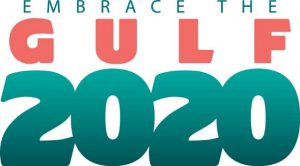
It is a fascinating group – and a commercial valuable one as well. Lots of bivalves are consumed in some form or fashion worldwide. Take some time at the beach to collect their shells as enjoy the great diversity and design within this group. EMBRACE THE GULF!
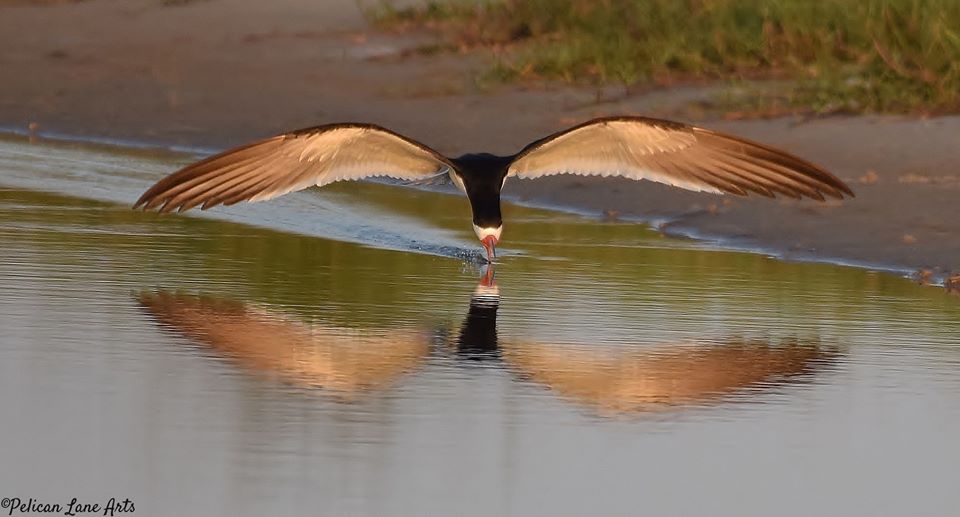
by Chris Verlinde | May 1, 2020
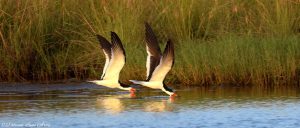
Black Skimmers foraging for fish. Photo Credit: Jan Trzepacz, Pelican Lane Arts.
Black Skimmers and Least Terns, state listed species of seabirds, have returned along the coastal areas of the northern Gulf of Mexico! These colorful, dynamic birds are fun to watch, which can be done without disturbing the them.
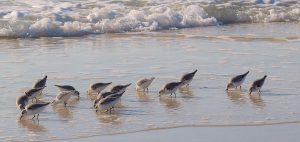
Shorebirds foraging. Photo Credit: Jan Trzepacz, Pelican Lane Arts.
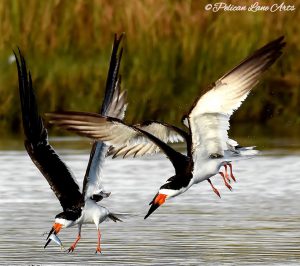
Black Skimmer with a fish. Photo Credit: Jan Trzepacz, Pelican Lane Arts.
What is the difference between a seabird and shorebird?
Among other behaviors, their foraging habits are the easiest way to distinguish between the two. The seabirds depend on the open water to forage on fish and small invertebrates. The shorebirds are the camouflaged birds that can found along the shore, using their specialized beaks to poke in the sandy areas to forage for invertebrates.
Both seabirds and shorebirds nest on our local beaches, spoil islands, and artificial habitats such as gravel rooftops. Many of these birds are listed as endangered or threatened species by state and federal agencies.
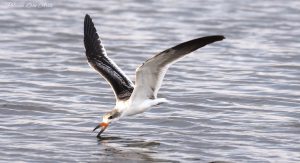
Juvenile Black Skimmer learning to forage. Photo Credit: Jan Trzepacz, Pelican Lane Arts.
Adult black skimmers are easily identified by their long, black and orange bills, black upper body and white underside. They are most active in the early morning and evening while feeding. You can watch them swoop and skim along the water at many locations along the Gulf Coast. Watch for their tell-tale skimming as they skim the surface of the water with their beaks open, foraging for small fish and invertebrates. The lower mandible (beak) is longer than the upper mandible, this adaptation allows these birds to be efficient at catching their prey.
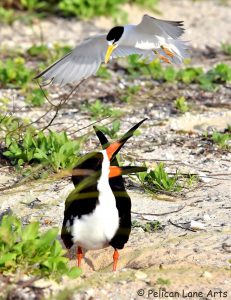
Least Tern “dive bombing” a Black Skimmer that is too close to the Least Tern nest. Photo Credit: Jan Trzepacz, Pelican Lane Arts.
Adult breeding least terns are much smaller birds with a white underside and a grey-upper body. Their bill is yellow, they have a white forehead and a black stripe across their eyes. Just above the tail feathers, there are two dark primary feathers that appear to look like a black tip at the back end of the bird. Terns feed by diving down to the water to grab their prey. They also use this “dive-bombing” technique to ward off predators, pets and humans from their nests, eggs and chicks.
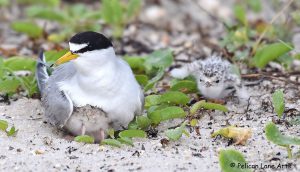
Least Tern with chicks. Photo Credit: Jan Trzepacz, Pelican Lane Arts.
Both Black Skimmers and Least Terns nest in colonies, which means they nest with many other birds. Black skimmers and Least Terns nest in sandy areas along the beach. They create a “scrape” in the sand. The birds lay their eggs in the shallow depression, the eggs blend into the beach sand and are very hard to see by humans and predators. In order to avoid disturbing the birds when they are sitting on their nests, known nesting areas are temporarily roped off by Audubon and/or Florida Fish and Wildlife Conservation Commission (FWC) representatives. This is done to protect the birds while they are nesting, caring for the babies and as the babies begin to learn to fly and forage for themselves.
Threats to these beautiful acrobats include loss of habitat, which means less space for the birds to rest, nest and forage. Disturbances from human caused activities such as:
- walking through nesting grounds
- allowing pets to run off-leash in nesting areas
- feral cats and other predators
- litter
- driving on the beach
- fireworks and other loud noises
Audubon and FWC rope-off nesting areas to protect the birds, their eggs and chicks. These nesting areas have signage asking visitors to stay out of nesting zones, so the chicks have a better chance of surviving. When a bird is disturbed off their nest, there is increased vulnerability to predators, heat and the parents may not return to the nest.
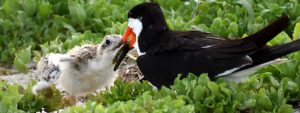
Black Skimmer feeding a chick. Photo Credit: Jan Trzepacz, Pelican Lane Arts.
To observe these birds, stay a safe distance away, zoom in with a telescope, phone, camera or binoculars, you may see a fluffy little chick! Let’s all work to give the birds some space.
Special thanks to Jan Trzepacz of Pelican Lane Arts for the use of these beautiful photos.
To learn about the Audubon Shorebird program on Navarre Beach, FL check out the Relax on Navarre Beach Facebook webinar presentation by Caroline Stahala, Audubon Western Florida Panhandle Shorebird Program Coordinator:
In some areas these birds nest close to the road. These areas have temporarily reduced speed limits, please drive the speed limit to avoid hitting a chick. If you are interested in receiving a “chick magnet” for your car, 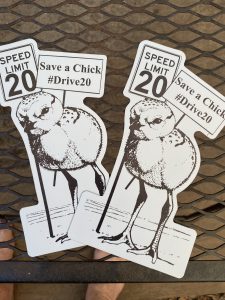 to show you support bird conservation, please send an email to: chrismv@ufl.edu, Please put “chick magnet” in the subject line. Please allow 2 weeks to receive your magnet in the mail. Limited quantities available.
to show you support bird conservation, please send an email to: chrismv@ufl.edu, Please put “chick magnet” in the subject line. Please allow 2 weeks to receive your magnet in the mail. Limited quantities available.
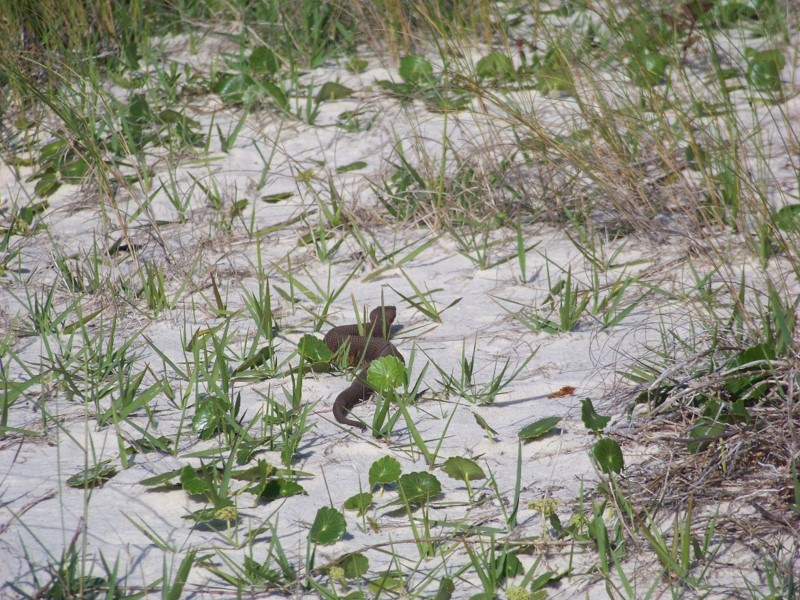
by Rick O'Connor | Feb 13, 2020
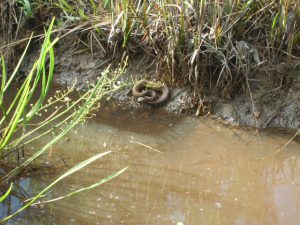
An eastern cottonmouth basking near a creek in a swampy area of Florida.
Photo: Tommy Carter
When you think of reptiles you typically think of tropical rainforest or the desert. However, there is at least one member of the three orders of reptiles that do live in the sea. Saltwater crocodiles are found in the Indo-Pacific region as are about 50 species of sea snakes. There is one marine lizard, the marine iguana of the Galapagos Islands, and then the marine (or sea) turtles. These are found worldwide and are the only true marine reptiles found in the Gulf of Mexico.
Sea turtles are very charismatic animals and beloved by many. Five of the seven species are found in the Gulf. These include the Loggerhead, which is the most common, the Green, the Hawksbill, the Leatherback, and the rarest of all – the Kemp’s Ridley.
Many in our area are very familiar with the nesting behavior of these long-ranged animals. They do have strong site fidelity and navigate across the Gulf, or from more afar, to their nesting beaches – many here in the Pensacola Beach area. The males and females court and mate just offshore in early spring. The females then approach the beach after dark to lay about 100 eggs in a deep hole. She then returns the to the Gulf never to see her offspring. Many females will lay more than one clutch in a season.
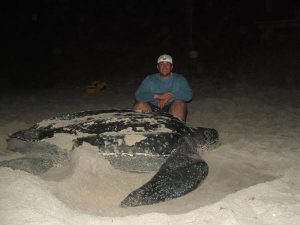
The largest of the sea turtles, the leatherback.
Photo: Dr. Andrew Colman
The eggs incubate for 60-70 days and their temperature determines whether they will be male or female, warmer eggs become females. The hatchlings hatch beneath the sand and begin to dig out. If they detect problems, such as warm sand (we believe meaning daylight hours) or vibrations (we believe meaning predators) they will remain suspended until those potential threats are no more. The “run” (all hatchlings at once) usually occurs under the cover of darkness to avoid predators. The hatchlings scramble towards the Gulf finding their way by light reflecting off the water. Ghost crabs, fox, raccoon, and other predators take almost 90% of them, and the 10% who do reach the Gulf still have predatory birds and fish to deal with. Those who make it past this gauntlet head for the Sargassum weed offshore to begin their lives.
These are large animals, some reaching 1000 pounds, but most are in the 300-400 pound range, and long lived, some reaching 100 years. It takes many years to become sexually mature and typically long-lived / low reproductive animals are targets for population issues when disasters or threats arise. Many creatures eat the small hatchings, but there are few predators on the large reproducing adults. However, in recent years humans have played a role in the decline of the adult population and all five species are now listed as either threatened or endangered and are protected in the U.S. There are a couple of local ordinances developed to adhere to federal law requiring protection. One is the turtle friendly lighting ordinance, which is enforced during nesting season (May 1 – Oct 31), and the Leave No Trace ordinance requiring all chairs, tents, etc. to be removed from the beach during the evening hours. There are other things that locals can do to help protect these animals such as: fill in holes dug on the beach during the day, discard trash and plastic in proper receptacles, avoid snagging with fishing line and (if so) properly remove, and watch when boating offshore to avoid collisions.
If we include the barrier islands there are more coastal reptiles beyond the sea turtles. There are freshwater ponds which can harbor a variety of freshwater turtles. I have personally seen cooters, sliders, and even a snapping turtle on Pensacola Beach. Many coastal islands harbor the terrestrial gopher tortoise and wooded areas could harbor the box turtles. In the salt marsh you may find the only brackish water turtle in the U.S., the diamondback terrapin. These turtles do nest on our beaches and are unique to see. Freshwater turtle reproductive cycles are very similar to sea turtles, albeit most nest during daylight hours.
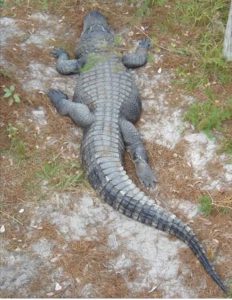
An American Alligator basking on shore.
Photo: Molly O’Connor
The American alligator can also be found in freshwater ponds, and even swimming in saltwater. They can reach lengths of 12 feet, though there are records of 15 footers. These animals actually do not like encounters with humans and will do their best to avoid us. Problems begin when they are fed and loose that fear. I have witnessed locals in Louisiana feeding alligators, but it is a felony in Florida. Males will “bello” in the spring to attract females and ward off competing males. Females will lay eggs in a nest made of vegetation near the shoreline and guard these, and the hatchlings, during and after birth. They can be dangerous at this time and people should avoid getting near.
We have several native species of lizards that call the islands home. The six-lined race runners and the green anole to name two. However, non-native and invasive lizards are on the increase. It is believed there are actually more non-native and invasive lizards in Florida than native ones. The Argentina Tegu and the Cuban Anole are both problems and the Brown Anole is now established in Gulf Breeze, East Hill, and Perdido Key – probably other locations as well. Growing up I routinely find the horned lizard in our area. I was not aware then they were non-native, but by the 1970s you could only find them on our barrier islands, and today sightings are rare.
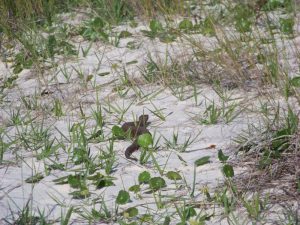
An eastern cottonmouth crossing a beach.
Photo: Molly O’Connor
Then there are the snakes.
Like all reptiles, snakes like dry xeric environments like barrier islands. We have 46 species in the state of Florida, and many can be found near the coast. Though we have no sea snakes in the Gulf, all of our coastal snakes are excellent swimmers and have been seen swimming to the barrier islands. Of most concern to residents are the venomous ones. There are six venomous snakes in our area and four of them can be found on barrier islands. These include the Eastern Diamondback Rattlesnake, the Pygmy Rattlesnake, the Eastern Coral Snake, and the Eastern Cottonmouth. There has been a recent surge in cottonmouth encounters on islands and this could be due to more people with more development causing more encounters, or there may be an increase in their populations. Cottonmouths are more common in wet areas and usually want to be near freshwater. Current surveys are trying to determine how frequently encounters do occur.
Not everyone agrees, but I think reptiles are fascinating animals and a unique part of the Gulf biosphere. We hope others will appreciate them more and learn to live with and enjoy them.
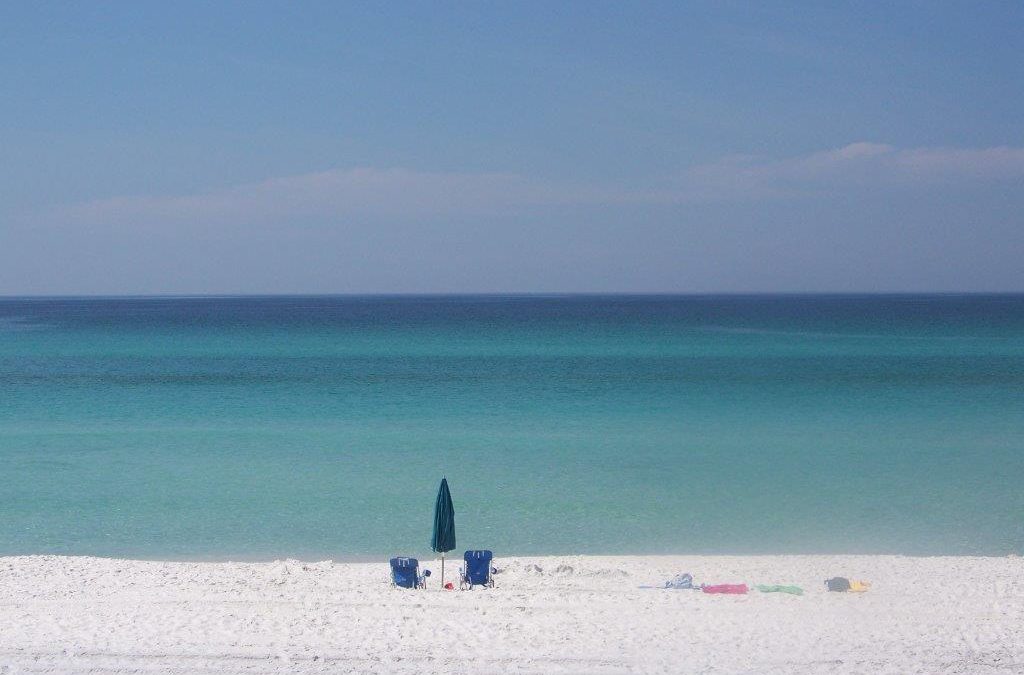
by Rick O'Connor | Jan 14, 2020
Standing on one of our local beaches, the Gulf of Mexico appears to be a wide expanse of emerald green and cobalt blue waters. We can see the ripples of offshore waves, birds soaring over, and occasionally dolphins breaking the surface. But few of us know, or think, about the environment beneath the waves where 99% of the Gulf lies. We might dream about catching some of the large fish, or taking a cruise, but not about the geology of the bottom, what the water is doing beneath the waves, or what other creatures might live there.
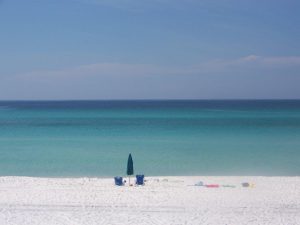
The Gulf of Mexico as seen from Pensacola Beach.
Photo: Molly O’Connor
Scanning the horizon from the beach, you are gazing at 600,000 square miles of open water. It is about 950 miles from the panhandle to Mexico. Traveling at 10 knots, it would take you about 3 days to cross at its widest point. The Gulf is almost an enclosed body of water. The bottom is somewhat “bowl” shaped with the deepest portion slightly west of center at a location known as the Sigsbee Deep. The island of Cuba serves as the “median” between where the ocean enters and exits the Gulf. Cycling water from the Atlantic crosses from Africa, through the Caribbean, and enters the between Cuba and the Yucatan. The seafloor here sinks and spills into the Sigsbee Deep. The pass between Cuba and Yucatan is about 6500 feet deep and the bottom of the Sigsbee Deep is about 12,000. If you are looking due south from the Florida Panhandle, you would be looking at this pass.
If your gaze shifted slightly to the right – maybe “1:00” – you would be looking at the Yucatan. The Yucatan itself forms a peninsula and a portion of it is below sea level extending further into the Gulf. This submerged portion of the Yucatan is what oceanographers refer to as a continental shelf. On the “leeward” side of the Yucatan Peninsula lies an area of the Gulf known as the Bay of Campeche. There is a shallow section of this “bay” known as the Campeche Banks which supports amazing fisheries and some mineral extraction. Off the Yucatan shelf there is a current of water that rises from the ocean floor called an upwelling. These upwellings are usually cold water, high in oxygen, and high in nutrients – producing an area of high biological productivity and good fishing.
Continuing to circle the Sigsbee Deep and looking about “2:00”, northwest of the Bay of Campeche, you enter the western Gulf which extends from Vera Cruz Mexico to the Rio Grande River in Texas. The shelf is much closer to shore here and the marine environment is still tropical. There is a steep continental slope that drops into the Sigsbee Deep. Water from the incoming ocean currents usually do not reach these shores, rather they loop back north and east forming the Loop Current. The shelf extends a little seaward where the Rio Grande discharges, leaving a large amount of sediment. In recent years, due to human activities further north, water volume discharge here has decreased.
In the direction of about “2:30”, is the Northwestern Gulf. It begins about the Rio Grande and extends to the Mississippi Delta. Here the continental shelf once again extends far out to sea. One of the larger natural coral reefs in the Gulf system is located here; the Flower Gardens. This reef is about 130 miles off the coast of Texas. The cap is at 55 feet and drops to a depth of 160 feet. Because of the travel distance, and diving depth, few visit this place. Fishing does occur here but is regulated. This shelf is famous for billfishing, shrimping, and fossil fuel extraction. The Mississippi River, 15th largest in the world and the largest in the Gulf, discharges over 590,000 ft3 of water per second. The sediments of this river create the massive marshes and bayous of the Louisiana-Mississippi delta region, which has been referred to as the “birds’ foot” extending into the Gulf. This river also brings a lot of solid and liquid waste from a large portion of the United States and is home to one of the most interesting human cultures in the United States. There is much to discuss and learn about from this portion of the Gulf over this series of articles.
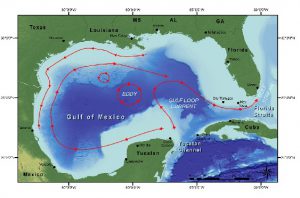
The basin of the Gulf of Mexico showing surface currents.
Image: NOAA
At this point we have almost completely encircled the Sigsbee Deep and move into the eastern Gulf. Things do change here. From the Mississippi delta to Apalachee Bay west of Apalachicola is what is known as the Northeastern Gulf – also known as the northern Gulf – locally called the Gulf coast. This is home to the Florida panhandle and some of the whitest beaches you find anywhere. Offshore the shelf makes a “dip” close to the beach near Pensacola forming a canyon known as the Desoto Canyon. The bottom is a mix of hardbottom and quartz sand. Near the canyon is good fishing and this area, along with the Bay of Campeche, is historically known for its snapper populations. It lies a little north of the Loop Current but is exposed to back eddies from it. Today there is an artificial reef program here and some natural gas platforms off Alabama.
Looking between “9:00-10:00” you are looking at the west coast of Florida and the Florida shelf. Here the shelf extends for almost 200 miles offshore. Off the Big Bend the water is shallow for miles supporting large meadows of seagrass and a completely different kind of biology. The rock is more limestone and the water clearer. In southwest Florida the grassflats support a popular fisheries area and a coral system known as the Florida Middle Grounds. At the edge of the shelf is a steep drop off called the Florida Escarpment, which forms the eastern side of the “bowl”. Another ocean upwelling occurs here.
Looking at “11:00” you are looking towards the Florida Keys. Between the Keys and Cuba is the exit point of the Loop Current called the Florida Straits. It is not as deep as here as it is between Cuba and the Yucatan; only reaching a depth of 2600 feet. This is mostly coral limestone and the base of one of the largest coral reef tracks in the western Atlantic. The coral and sponge reefs, along with the coastal mangroves, forms one of the more biological productive and diverse regions in our area. It supports commercial fishing and tourism.

We did not really talk about the bottom of the “bowl”. Here you find remnants of tectonic activity. Volcanos are not found but you do find cold and hot water vent communities, which look like chimneys pumping tremendous amounts of thermal water from deep in the Earths crust. These vent communities support a neat group of animals that we are just now learning about. Brine lakes have also been discovered. These are depressions in the seafloor where VERY salty water settles. These “lakes” have water much denser than the surrounding seawater and can even create their own waves. Many of them lie as deep as 3300 feet and can be 10 feet deep themselves. There is one known as the “Jacuzzi of Despair”. They are so salty they cannot support much life.
In the next addition to this series we will begin to look at the some of the interesting plant and animals that call the Gulf home.
Embrace the Gulf.
































